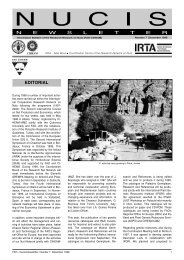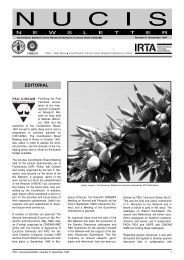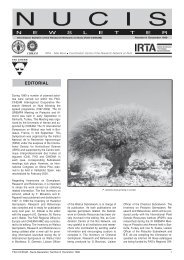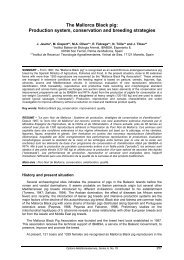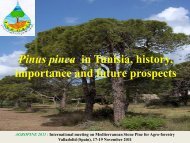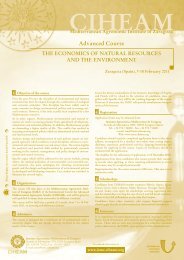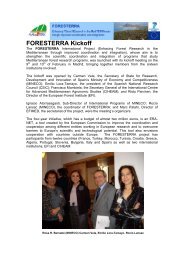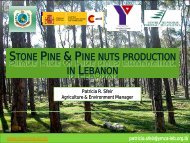ISHS International Congress on Hazelnutwas held in Tarragona, Spain and theproceedings will be published in ActaHorticulturae. During 2004 two moreSymposia are planned: (i) the III ISHS InternationalSymposium on Chestnut to beheld in October in Portugal, Chaves, VilaReal; and (ii) the V ISHS InternationalWalnut Symposium to be held in Sorrento,Italy in November.The Network’s Coordinator participated intwo Scientific Committee Meetings andthe Convention of the International TreeNut Council (INC) held in Berlin (Germany)and Las Vegas (USA) respectively.The importance of promoting the healthycomponent of nut consumption in the humandiet through advertisement wasstressed. This is considered essential forsuccessful marketing and to sustain demand.Worldwide nut production is increasingover the years and its supply istaken by the also increasing world consumption.It seems that nut markets canbe further developed. The INC expressedan interest to collaborate and work closelywith the Nut Network. The issues ofpreventing and reducing kernel’s aflatoxincontamination through better crop preharvestand postharvest management is ofparamount importance for the INC.Almond trees starting bloom at IRTA,E.E. Lleida, SpainESCORENA’s reviewThe ESCORENA networks can be classifiedinto three groups according to thefield of agricultural activity: crop production,animal production and environment.The 23 rd Regional Conference for Europe(Nicosia, Cyprus, May 2002) recognizedthe importance of ESCORENA as the researchnetworks brought added value notonly to European scientists and their researchinstitutions, but also to partnersand beneficiaries beyon European borders.Furthermore, the Conference endorsedthe recommendation of the 32 ndSession of the European Commission onAgriculture (ECA) that an assessmentand evaluation be undertaken for eachnetwork. During 2003, this assessmentwas carried out by M. Larbier, a visitingscientist seconded to FAO by INRA, andhis report and proposals for the futurewere submitted to the 33 rd Session ofECA held in Rome in March <strong>2004.</strong> OurReseach Network on Nuts was consideredamong those ten to be retained andfor having good potential for continuity inthe future. This conclusion was reacheddue to dynamic coordination, adaptationof research towards the aim of sustainabledevelopment, importance of the programmeand quality of the scientific andtechnical communication means used.The ECA was also informed of CIHEAM’sintention to continue to cooperate and cosponsorthree of these ten networks, includingour Nut Network. The report submittedto the ECA included an estimate ofthe necessary funds needed to ensure futurefunctioning of ESCORENA. Consideringthe budgetary constraints faced byFAO, the proposal to establish a multi-donorTrust Fund was made. The ECA reportwas submitted to the 24 th FAO RegionalConference for Europe (Montpellier,May 2004) but no decission on this issuewas taken. It seems that the financialsupport towards our Network by themember countries under circumstancesof financial difficulties and uncertainty isessential to foster activities.The Nut Network’s futureNut tree production, trade and industry isan important economical activity relatedto sustainable agriculture, often in marginallands, in both European and NearEastern Regions. Nuts are of major importanceand are typical components ofthe traditional and healthy Mediterraneandiet. To accomplish sustainable developmentand food security, a future combinedeffort in R&D, environmental managementand communication is needed.Due to overall budgetary constraints, theNetwork on Nuts has in recent years, undergonea restructuring exercise which isnow <strong>full</strong>y implemented. Thus, the Networkhas reorganized and simplified its structureand is trying to focus more on developmentoriented issues rather than its previousstrong genetic resources collection,description and improvement. In addition,as a result of the assessment carried outin 2003 mentioned above, two workinggroups: Genetic Resources and Economicswere suggested for elimination.Considering the current and future relevanceof the Network, it is generally seenby its members as a useful tool for bettercollaboration, and the opportunities tocome together are viewed as very importantfor project development. Accordingly,recent Network developments are focusedon research issues which are of priorityimportance for developing countriesand for countries in transition, particularlyin the Balkans, Caucasus and North Africa,but also beyond, wherever researchresults are relevant to stimulate growthand alleviate poverty and hunger. The relevanceand potential usefulness of ourNut Network is based on the availabilityof considerable genetic resources andtechnical experience for the developmentof nut tree crops in Europe and the NearEast regions. In addition, useful contributionsto rural development and the globalgenetic resources understanding can bemade. Major research areas of broad interest,which should be addressed are: foodsafety, biodiversity, biotechnology and sustainablemanagement of natural resources,including low-input agriculture. To strengthenFAO’s support to our Network it is necessaryto adopt a “project approach” ofactivities. This should be carried out incollaboration with relevant FAO Units.Genetic resources inventoriesThree Inventories on Germplasm, Researchand References have been alreadypublished: Almond (1997, RTS 51),Hazelnut (2000, RTS 56) and Chestnut(2001, RTS 65). These inventories publishedin the REU Technical Series(http://www.fao.org/regional/europe/PUB),are important compilations of the currentlyavailable species genetic resourcesand information on ongoing research projectsand bibliography. In addition, twomore inventories are being compiled andare at different stages of completion. TheInventory on Walnut being compiled by E.Germain is to be published shortly andthe Inventory on Pistachio is being collatedby N. Kaska and B.E. Ak. All thesecatalogues are being supported by FAO’sRegional Office for Europe and the Seedand Plant Genetic Resources Service(AGPS) together with CIHEAM-<strong>IAMZ</strong>.In addition, a draft Descriptors List forHazelnut has been developed by membersof the Network and has now beensubmitted to IPGRI for assessment andeventual editing and publication.Changes in the FAO Regional Officefor EuropeAs mentioned above, Mr. Michel Larbier,a visiting scientist seconded from INRA,France, took the task to evaluate andsuggest a proposal to re-organize ESCO-RENA. The efforts made by M. Larbier inreviewing the whole ESCORENA systemare acknowledged. Ms. Jutta Krause, RegionalRepresentative for Europe (FAORegional Office for Europe in Rome) isthe FAO contact person for ESCORENA.2 FAO-CIHEAM - Nucis-Newsletter, Number 12 <strong>September</strong> 2004
The Nut Network on the webIn addition to the already existing informationon the Nut Network at http://www.iamz.<strong>ciheam</strong>.org/ingles/nuts.htm,and on the previous FAO web page createdin 2000, the FAO European System ofCooperative Research Networks in Agriculture(ESCORENA) and the Nut Networkweb page has now been closed dueto lack of commitment from coordinatorsto make use of the interactive system fordata entry and lack of resources fromFAO to take over this role. However, essentialinformation on network coordinators,major network publications (e.g.REU Technical Series), ESCORENA reportsand links to existing network websitessuch as the nut network is included inthe REU website (see http://www.fao.org/world/regional/REU/content/escorena/index_en.htm ).<strong>NUCIS</strong> on the webA short version of the Newsletter (editorial,contents and back page) from issue<strong>number</strong> 6 and onwards, is available onthe Internet web <strong>pages</strong> of both FAO (http://www.fao.org/regional/europe/public-e/nucis.htm) and CIHEAM (http://www.iamz.<strong>ciheam</strong>.org/ingles/nuts.htm# publications).A <strong>full</strong> electronic version of NU-CIS is available from issue <strong>number</strong> 9 andonwards (http://www.iamz.<strong>ciheam</strong>.org/ingles/nucis9.pdf).The contents of thisNewsletter can be browsed through andalso copied and printed.Contributions to <strong>NUCIS</strong>As in past <strong>NUCIS</strong> editorials, it is againstressed that this Newsletter must be aneffective vehicle of communication for allthe Network members. The <strong>pages</strong> of thisbulletin are open to all readers who wouldlike to suggest ideas or to express theiropinion about the work developed by theNetwork (activities carried out and planned)or to publish short articles and reportson relevant horticultural subjects ofgeneral interest. A sufficient <strong>number</strong> ofcontributions are received from the MediterraneanBasin and overseas for the articlesand reports section. However, thesections on news and notes and also oncongresses and meetings are usually difficultto cover due to the scarce informationreceived and thus, contributions aremost welcomed. Otherwise, the Editorhas to report on the issues he is aware of,but certainly there must be many more issueson-going throughout the year whichmerit reporting. Also, the place for ‘grey’bibliography (references and documentswhich are difficult to search like Mastersor Ph. Theses) is scarcely filled.The <strong>NUCIS</strong> Newsletter is distributedworldwide free of charge to 1.400 readersfrom over 60 countries. The disseminationof information originated by the Networkis of paramount importance and throughthis bulletin has been largely successful.The first <strong>NUCIS</strong> was published in 1993,this issue of the <strong>NUCIS</strong> Newsletter is<strong>number</strong> 12 and during these eleven yearsgreat editing effort has been made. I acknowledgeand grate<strong>full</strong>y thank all contributorsfor their efforts and interest to produceand send me valuable information.The exchange of information betweenNetwork members through the <strong>pages</strong> ofthis Newsletter is the basis for developingcollaboration. The editing task in the eleven<strong>NUCIS</strong> issues already published hasbeen huge (<strong>NUCIS</strong> 1, 9 <strong>pages</strong>; 2, 20 <strong>pages</strong>;3, 24 <strong>pages</strong>; 4, 28 <strong>pages</strong>; 5, 36 <strong>pages</strong>;6, <strong>52</strong> <strong>pages</strong>, 7, 44 <strong>pages</strong>, 8, 46 <strong>pages</strong>9, 68 <strong>pages</strong>, 10, 48 <strong>pages</strong>, 11, 48 <strong>pages</strong>and 12, <strong>52</strong> <strong>pages</strong>). In order to reducethe time consuming formal editing contributorswho send articles, news, notes, bibliographicreferences, etc. to the differentsections are asked to provide themwell organized and elaborated. Informationshould be sent in satisfactory English.Contributions could be sent throughInternet using the Editor’s email. The alternativeis to provide them on disketteand also in printed format. This bulletin isreproduced in black and white only, includingpictures. Please send your contributionsfor the next issue, <strong>number</strong> 13 by theend of October 2005; however it cannotbe guarantied that the article will be publisheddue to the uncertainty of funding.We apologize to readers for the delay inprinting this issue due to late funding. Wethank all who have contributed to this issue.The EditorThe designations employed and thepresentation of material in this publicationdo not imply the expression of anyopinion whatsoever on the part of theFood and Agriculture Organization ofthe United Nations concerning the legalstatus of any country, territory, city orarea or of its authorities, or concerningthe delimitation of its frontiers or boundaries.This publication contains the collectiveviews of an international group of expertsand does not necessarily representthe decisions or the stated policyof the Food and Agriculture Organizationof the United Nations, the InternationalCentre for Advanced MediterraneanAgronomic Studies nor of the Organizationfor the Economic Cooperationand Development.Contributions should be written conciselyin English. Please send contributionson paper and diskette (Microsoft ®Word or Word Perfect ® ). Authors areresponsible for the content of their papers.Reproduction of the articles is authorized,provided that the original sourceis clearly stated.CONTENTSEDITORIAL .......................................... 1ARTICLES AND REPORTS• Consumers’ acceptance of industrial productsmade with hazelnuts and almonds .............................. 4• Differential flower and fruit damagesby spring frosts in almond .......................................... 5• Prunus webbii as a way to look intoself-compatibility in almond ....................................... 8• Application of molecular markers in almondbreeding programmes ................................................ 9• Fusicoccum canker in almond orchards –biotechnology tools for early selectionof tolerant genotypes ................................................ 12• Virus screening for Australian almonds .................... 15• The pistachio industry in Italy: current situationand prospects ........................................................... 16• Pistachio production in Tunisia ................................ 19• Breeding monoecious pistachio cultivars ................. 21• Chilling stress and injury in pistachiofemale flowers .......................................................... 23• Underground drip system: the new irrigation methodfor pistachio and almond orchard in Turkey ............. 24• Iranian agricultural system to develop higher qualityand healthier pistachio production ........................... 26• Pistacia vera L. 1753 in Iran ..................................... 26• Pistacia atlantica desf. 1800 in Iran .......................... 27• Pistacia khinjuk stocks 18<strong>52</strong> in Iran ......................... 30• Germplasm collection of pistacia at the JacobBlaustein Institute for desert research. Phenotypictraits and molecular markers .................................... 31• Where in a pistachio tree is Xanthomonasand how did it get there? .......................................... 33• Chestnut production in Andalusia ............................. 33• The world macadamia industry and researchactivities ................................................................... 36• Carob tree development in China .............................. 39NOTES AND NEWS• In memorian: my professor Dale Kester ................... 41CONGRESSES AND MEETINGSPage• XIII GREMPA meeting on pistachios and almonds ... 41• VI International Congress on Hazelnut ...................... 42TO BE HELD ................................................................. 45BIBLIOGRAPHY ........................................................... 46BACKPAGE ................................................................... <strong>52</strong>FAO-CIHEAM - Nucis-Newsletter, Number 12 <strong>September</strong> 20043



